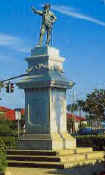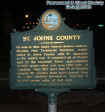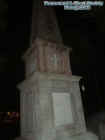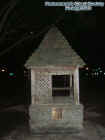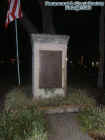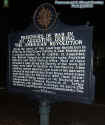|
|
||
|
In the late 1600s Governor Mendez de Canzo had a Market Place built which sits in the center of St. Augustine before that I believe this was swamp land. He had this built so that fish and meat could be sold here. This was also the first place that had weights and measures in the United States. The residents could leave there home and pick up the necessary goods here. This was also the location of the guard house. When the British owned it they had a bell that rung here. Some use to call this Market Place the Slave Market whether this is true or not I do not know but slavery was not uncommon during those times. From the onset of the American Revolution in 1775 the British Crown Colony in East Florida was a Loyalist Bastion. In its capital St. Augustine the British lodged as prisoners many American Patriots and their French Allies. Most of these prisoners were given liberty of the town, but some were held in Castillo de San Marcos. A few housed in the unfinished State House which stood where some of the park/plaza is today. By the end of 1780 these prisoners included three signers of the Declaration Of Independence by the names of Thomas Heyward Jr., Arthur Middleton, and Edward Rutledge. On July 4, 1781 the Patriot captives celebrated Independence Day. In 1785 Thomas Bell died at the town plaza have fell wounded. He was one of the pirate leaders who attacked Jesse Fish's home on Anastasia Island. I do not have much more information on how he was killed but it was near the Market Place that much I do know. In 1813 a large obelisk was erected to Commemorate the Spanish Liberal Constitution of 1812. Then in 1825 St. Augustine faced a horrible hurricane the entire plaza was knocked down and the market house wad destroyed. Some of the orange harvest was lost. The plaza was damaged from the storm. A new market was built in 1840 which burned later in 1887 and eventually rebuilt again. The Cathedral Basilica built in the 1700s had burned in 1887 near the plaza. Trinity Church and the post office once a Spanish Government building also boarders the plaza. In 1872 a giant monument was erected to the citizens who died serving the Confederates in the Civil War. If you were to walk in the plaza today it serves as a little park. The two monuments still stand along with a giant gazebo. There is also cannons and cannon balls throughout the park and an old well. One could sit on the bench and just sit back and enjoy a historical view of St. Augustine. The park is not very large but since it sits in the heart of St. Augustine it was a place of many fires and massacres which took place surrounding it so the thought of it being haunted are as true just as the rest of the city. Today it is called the Plaza De La Constitucion. © By Rick-AngelOfThyNight |
||
|
|
|





